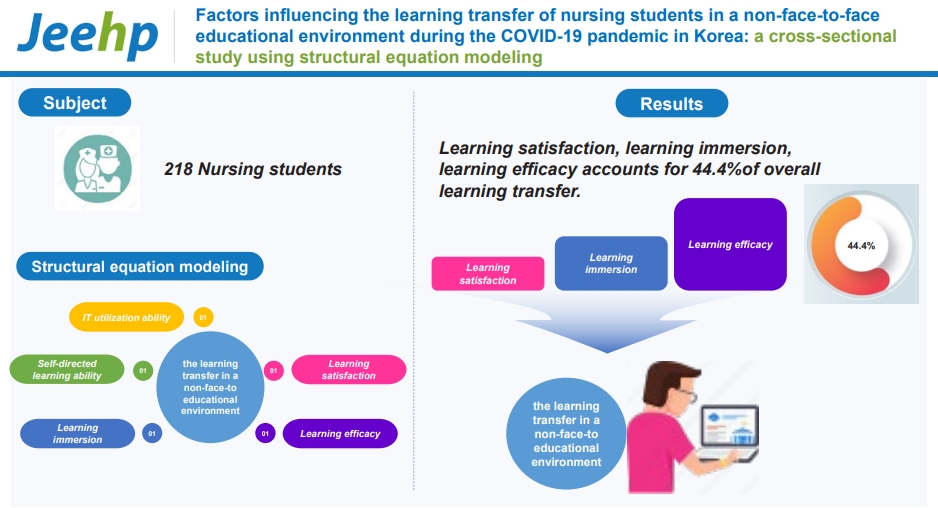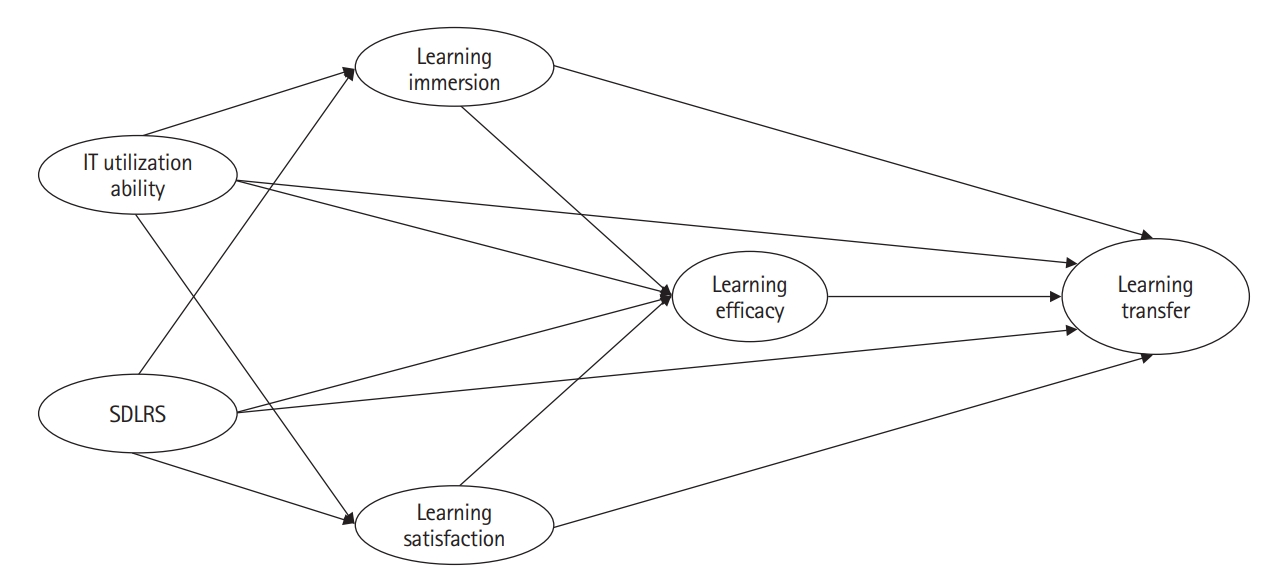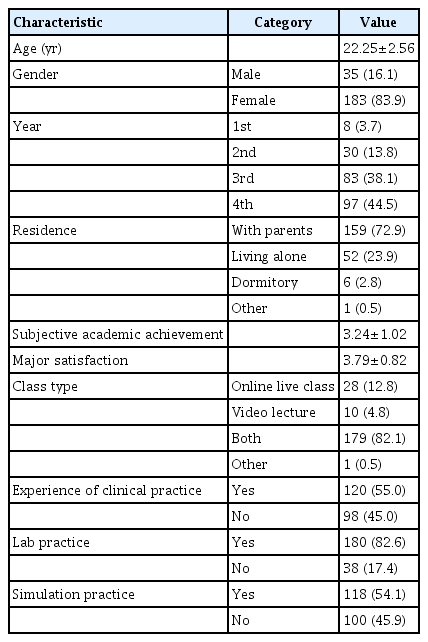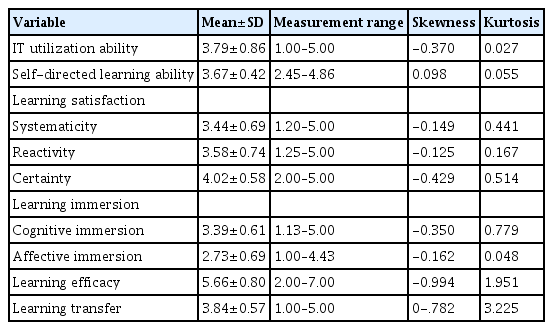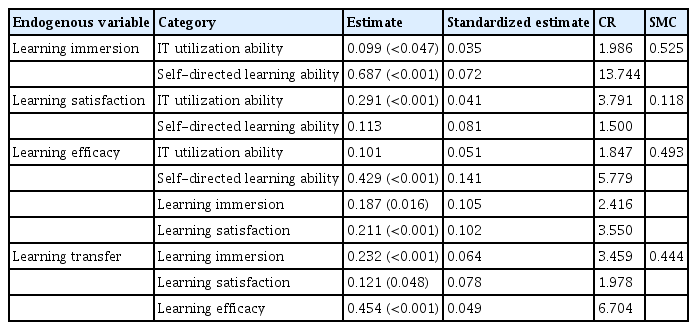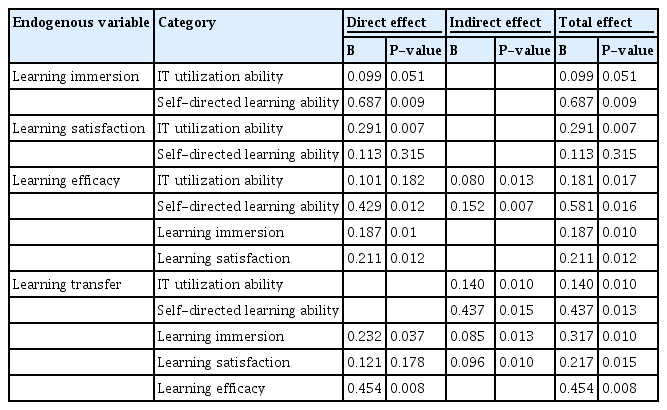Factors influencing the learning transfer of nursing students in a non-face-to-face educational environment during the COVID-19 pandemic in Korea: a cross-sectional study using structural equation modeling
Article information
Abstract
Purpose
The aim of this study was to identify factors influencing the learning transfer of nursing students in a non-face-to-face educational environment through structural equation modeling and suggest ways to improve the transfer of learning.
Methods
In this cross-sectional study, data were collected via online surveys from February 9 to March 1, 2022, from 218 nursing students in Korea. Learning transfer, learning immersion, learning satisfaction, learning efficacy, self-directed learning ability and information technology utilization ability were analyzed using IBM SPSS for Windows ver. 22.0 and AMOS ver. 22.0.
Results
The assessment of structural equation modeling showed adequate model fit, with normed χ2=1.74 (P<0.024), goodness-of-fit index=0.97, adjusted goodness-of-fit index=0.93, comparative fit index=0.98, root mean square residual=0.02, Tucker-Lewis index=0.97, normed fit index=0.96, and root mean square error of approximation=0.06. In a hypothetical model analysis, 9 out of 11 pathways of the hypothetical structural model for learning transfer in nursing students were statistically significant. Learning self-efficacy and learning immersion of nursing students directly affected learning transfer, and subjective information technology utilization ability, self-directed learning ability, and learning satisfaction were variables with indirect effects. The explanatory power of immersion, satisfaction, and self-efficacy for learning transfer was 44.4%.
Conclusion
The assessment of structural equation modeling indicated an acceptable fit. It is necessary to improve the transfer of learning through the development of a self-directed program for learning ability improvement, including the use of information technology in nursing students’ learning environment in non-face-to-face conditions.
Introduction
Background/rationale
Even after the end of the coronavirus disease 2019 (COVID-19) pandemic, non-face-to-face classes are expected to be used selectively in all educational environments in the future. In addition, as the demand for digital changes, including artificial intelligence, the internet of things, augmented reality, and virtual reality, is incorporated into the school environment, strategies for improving the quality of education are needed.
Nursing students complete a curriculum consisting of theoretical education, on-campus practice, and various clinical practices. Therefore, to effectively apply the knowledge and experience learned in theory and practice in nursing school to the clinic, it is essential to have the ability to transfer learning in order to effectively apply the acquired knowledge, skills, and behaviors to work on an ongoing basis [1]. Ford and Weissbein [2] defined learning transfer as the generalization and maintenance of knowledge and skills acquired in education and training situations for a certain period in practical situations. Keller explained the intrinsic and extrinsic aspects of the abstract concept of motivation through the attention, relevance, confidence, and satisfaction (ARCS) model and stated that intrinsic and extrinsic motivation can be enhanced by these 4 factors [3]. In other words, for learning to take place, first of all, attention must be paid, teaching contents and methods must be relevant to learners, learners must be able to have confidence in being able to succeed, and learners must be able to feel a sense of accomplishment. In a previous study, the 4 main factors mentioned in the ARCS theory by Keller [4] were reported to have a significant effect on learning immersion [5].
According to the learning transfer model of Ayres [6], the result of education is learning transfer, and factors that facilitate this process include characteristics such as the degree of the individual’s relevant knowledge, skills, abilities, and individual experience before education and the relevance of the educational program. It was shown that personal and environmental factors also affect learners’ learning satisfaction, which is a factor linked to learning motivation [6]. These factors are related to the design factors of the educational program itself, meaning that learning transfer should be effective. In particular, the ability to use information technology (IT) in a non-face-to-face class situation can be considered a personal characteristic.
Most prior studies on learning transfer have been conducted among entrepreneurs [7]. Therefore, in this study, based on the theories of Keller [4] and Ayres [6] related to learning transfer, a model explaining the relationship between various factors affecting learning transfer in nursing students was constructed and verified.
Objectives
The aim of the study was to identify the factors influencing the learning transfer of nursing students in a non-face-to-face educational environment during the COVID-19 pandemic through structural equation modeling. Specifically, a structural equation model was constructed and the model fitness for paths affecting learning transfer was tested.
Methods
Ethics statement
This study received approval from the Ethics Committee (Institutional Review Board) of Gangneung Wonju National University (2021-33-1). Informed consent was obtained from the participants during the first part of the online survey.
Study design
This was a cross-sectional study. A hypothetical model was constructed based on the learning transfer model of Keller [4] and Ayres [6] and related literature as follows (Fig. 1).
Setting
Data were collected using a Google online survey from February 9 to March 1, 2022. The survey was distributed to nursing students at Gangneung Wonju National University.
Participants
The targets of this study were 218 nursing students (83.9% female) aged over 20 years (mean±standard deviation [SD]=22.25±2.56 years). The inclusion criterion was all nursing students who were registered at the university. There were no exclusion criteria.
Variables
There were 6 variables in this study: learning transfer, learning immersion, learning satisfaction, learning self-efficacy, self-directed learning ability, and IT utilization ability. Self-directed learning ability and IT utilization ability were exogenous variables. Learning immersion, learning satisfaction, and learning self-efficacy were endogenous variables to make a hypothetical model of factors that affect learning transfer. Self-directed learning ability refers to the type of learning in which the entire process related to learning is selected and decided according to one’s own will, and IT utilization ability refers to the ability to use information and communication devices. Learning immersion means a state of psychological concentration where one is deeply immersed in learning utilization, learning satisfaction denotes satisfaction with the learning process and results, and learning self-efficacy denotes personal belief in whether the relevant content is learned.
Data sources/measurement
In this study, a questionnaire containing 81 items in 6 categories was used: learning transfer (4 items, 5-point Likert scale) developed by Lee [8] based on the research of Rouiller and Goldstein [9]; learning immersion (29 items, 5-point Likert scale) developed by Kim et al. [10]; learning satisfaction (15 items, 5-point Likert scale) developed by Bae et al. [7]; learning self-efficacy (10 items, 7-point Likert scale) developed by Ayres [6] and translated into Korean by Park and Kweon [11]; self-directed learning ability (22 items, 5-point Likert scale) developed by Guglielmino [12] and modified by Kim and Lee [13]; and IT utilization ability (single item, 5-point Likert scale). The 5-point Likert scale extended from “extremely disagree” (1) to “extremely agree” (5), and the 7-point Likert scale ranged from “extremely disagree” (1) to “extremely agree” (7). The Cronbach α values of all measurement tools were more than 0.7, indicating reliability.
Bias
No bias was found in selecting participants.
Study size
The sample size met the criterion according to which more than 200 samples are required to verify a structural equation model [14]. Data were collected from 218 students, and all 218 responses were used in the final analysis.
Statistical methods
The collected data were analyzed using IBM SPSS for Windows ver. 22.0 (IBM Corp.) and AMOS ver. 22.0 (IBM Corp.). The variables related to participants’ general characteristics were analyzed in terms of frequency, percentage, mean, and SD as descriptive statistics. The multivariate normality of the sample was verified by mean values, SD, skewness, and kurtosis. The model fit was tested using the χ2 test (chi-square value, CMIN), normed χ2 test (CMIN/degrees of freedom), goodness-of-fit index (GFI), adjusted goodness-of-fit index (AGFI), comparative fit index (CFI), a non-normed fit index (Tucker-Lewis index, TLI), normed fit index (NFI), standardized root mean square residual (SRMR), and root mean square error of approximation (RMSEA). The significance of the estimated coefficient for each path in the hypothetical model was analyzed through the critical ratio and P-value (P<0.05). The bootstrapping method was used to assess the statistical significance of the direct, indirect, and total effects of the hypothetical model.
Results
Participants
All of the 218 targeted nursing students participated in this survey. Their average age was 22.25 years. Most (83.9%) were women, 44.5% were in the fourth year of their program, and 72.9% were living with their parents. The average score for self-perceived IT utilization ability was 3.79 points, that for academic achievement was 3.24 points, and that for major satisfaction was 3.79 points. The most common form of non-face-to-face classes experienced at university was real-time online classes and video-recorded lectures (82.1%). Furthermore, 55.0% of participants responded that they had experience in clinical practice, 82.6% stated that they had experience in laboratory practice, and 54.1% reported that they had experience in simulation practice (Table 1).
Main results
Descriptive statistics and confirmatory factor analysis of the measured variables
The descriptive statistics of the 6 measured variables are presented in Table 2 (Dataset 1). Confirmatory factor analysis was performed to evaluate the degree of validity of the factors. Three items with a standard factor loading (λ) <0.50 were excluded. The standard factor loading of the other variables was above the baseline value (λ>0.5), the construct validity was above 0.80, and the average was above 0.50, indicating no issue with convergent validity.
We further examined the correlations between the correlation matrix and the average to verify discriminant validity. This analysis demonstrated that the values of the multiple correlation coefficients were small enough to ensure the factorial discriminant validity, with values ranging between 0.04 and 0.80 (i.e., with absolute values less than 0.85).
Goodness-of-fit testing of the model
Prior to hypothetical model verification, confirmatory factor analysis demonstrated that the subjective IT utilization ability, self-directed learning ability, learning satisfaction, learning immersion, and learning self-efficacy of nursing students’ learning transfer were relatively good, and the hypothetical model was verified without model modification. The fit indices of the model in this study were as follows: χ2=33.07, normed χ2=1.74 (P=0.024), GFI=0.97, AGFI=0.93, CFI=0.98, RMR=0.02, TLI=0.97, NFI=0.96, and RMSEA=0.06 (Table 3).
Analysis of the hypothetical model
The hypothetical model analysis showed that 9 out of the 11 pathways of the hypothetical structural model for learning transfer in nursing students were statistically significant (Fig. 2). For learning immersion, subjective IT utilization ability (β=0.099, P=0.047) and initiative (β=0.687, P<0.001) appeared as statistically significant paths. The explanatory power of IT utilization ability and self-directed learning ability for learning immersion was 52.5%. For learning satisfaction, subjective IT utilization ability (β=0.291, P<0.001) appeared as a statistically significant path, and the explanatory power of variables for learning satisfaction was 11.8%. For learning self-efficacy, initiative (β=0.429, P<0.001), immersion (β=0.187, P=0.016), and satisfaction (β=0.211, P<0.001) were identified as significant pathways, and the explanatory power of initiative, learning flow, and learning satisfaction for learning satisfaction was 49.3%. For learning transfer, learning immersion (β=0.232, P<0.001), learning satisfaction (β=0.121, P=0.048), and learning self-efficacy (β=0.454, P<0.001) were found to be significant pathways. The explanatory power of immersion, satisfaction, and self-efficacy for learning transfer was 44.4% (Tables 4, 5 and Fig. 2).
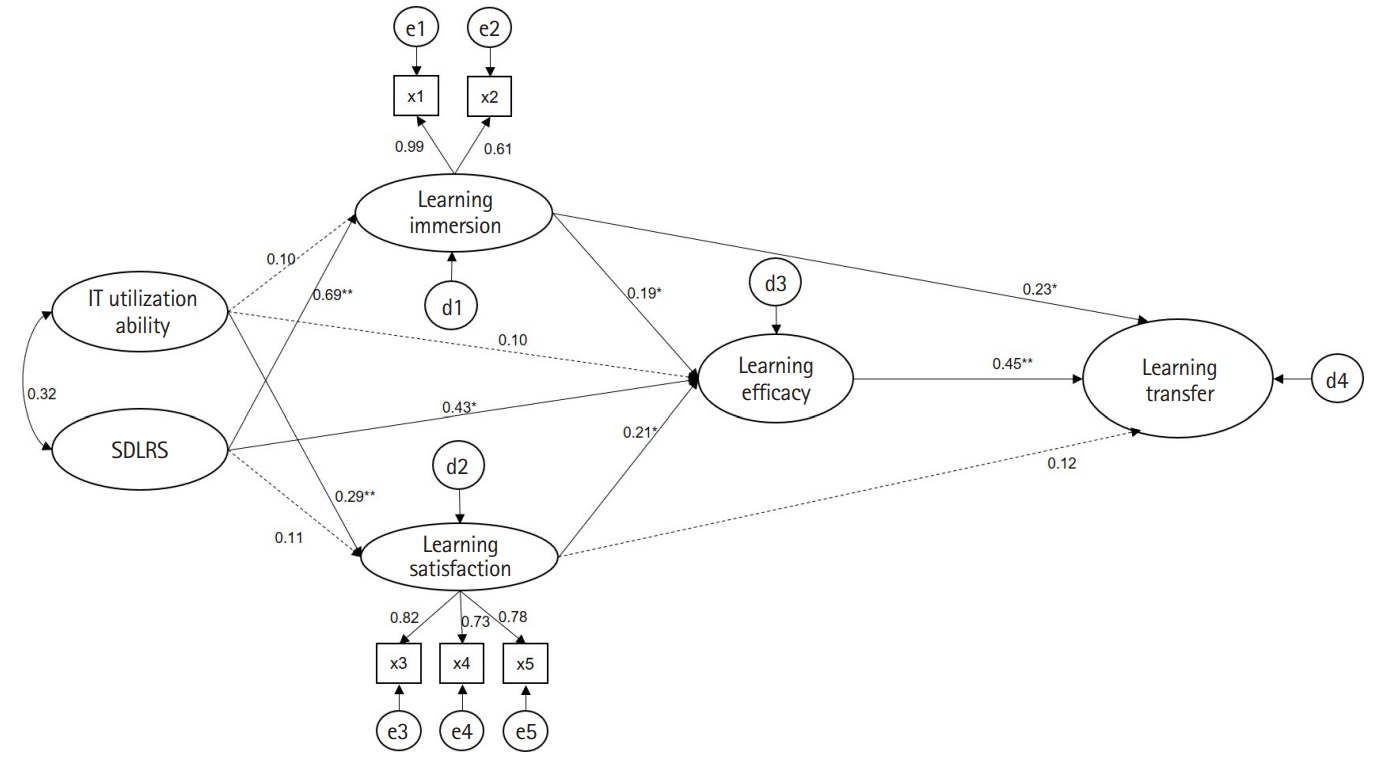
Effect analysis in the structural equation model. IT, information technology; SDLRS, Self-Directed Learning Readiness Scale; X1, cognitive immersion; X2, affective immersion; X3, systematic satisfaction; X4, reactive satisfaction; X5, affirmative satisfaction. *P<0.05. **P<0.01.
Discussion
Key results
Nursing students’ learning self-efficacy and learning flow directly affected learning transfer, and subjective IT utilization ability, self-directed learning ability, and learning satisfaction were variables with indirect effects. The explanatory power of variables influencing the learning transfer of nursing students was 44.4%.
Interpretation
Self-directed learning ability did not affect learning transfer directly; instead, it seemed to affect learning transfer through learning self-efficacy. Learning self-efficacy was found to be the most influential factor in learning transfer among nursing students. The factor that had the most significant influence on learning self-efficacy was self-directed learning ability. In an educational environment that has suddenly changed to non-face-to-face due to COVID-19, students learn independently and autonomously without the support of others; however, the ability and behavioral elements that individuals have for leading learning activities are derived from their experiences with face-to-face education. This behavioral change in learning activities among students has a greater influence than in the context of distance learning. It is not easy to immediately ascertain whether a student has understood the learning content conveyed through certain content. When learning occurs in a situation where teachers and students are not face-to-face, students’ ability and behavior in self-directed learning activities have a more significant impact than in face-to-face education situations.
The next factors influencing the learning transfer of nursing students were learning immersion and learning satisfaction. Satisfaction with learning can enhance the knowledge and skills that students need to learn by themselves by increasing their confidence in learning or self-efficacy.
Finally, nursing students’ IT utilization ability was found to have an indirect effect on their learning transfer. In the environment that suddenly changed after the start of the COVID-19 pandemic, nursing education was converted to non-face-to-face education, for both theoretical and practical education. IT utilization ability is essential in the remote education environment in the era of COVID-19.
Comparison with previous studies
In the non-face-to-face educational environment implemented during the COVID-19 pandemic, interaction between students and professors and between students is difficult; thus, immersion in learning and satisfaction with learning may decrease. Studies have also shown benefits of social interactions in the lecture for students’ learning [15]. A sense of belonging is often fostered through academic social interactions, and if students do not feel like they belong, they may be less driven to complete their academic work [16]. Students have often experienced loneliness during the pandemic, and the lack of face-to-face social interactions during the pandemic is not only connected to feelings of isolation, but might also be a serious cause of stress for students [17].
Limitations/generalizability
This study collected data from nursing students in 2 regions of Korea, and the results might not be fully generalizable to all nursing students and all college students. In addition, since the path from learning transfer to learning performance was not analyzed in this study, it cannot be asserted that all of the students achieved learning transfer to learning performance.
Implications
For learning activities in a non-face-to-face environment, such as non-face-to-face classes, expectations are rising for the content presented and the ability to use IT in the learning environment to present the learning content. In addition, an active information processing process is required, such as constructing new knowledge based on individual abilities. Therefore, it is necessary to improve the transfer of learning through the development of a self-directed program for learning ability improvement, including the use of IT in the learning environment of nursing students in a non-face-to-face situation.
Conclusion
In this structural equation model, subjective IT utilization ability, initiative, immersion, learning satisfaction, and learning self-efficacy had an explanatory power of 44.4% (i.e., middle level) for learning transfer among nursing students. Because the personal factors and learning motivation variables selected in the hypothetical model of this study were appropriately selected to explain nursing students’ learning transfer, it is judged that the variables are appropriate. Therefore, the variables presented in this study must be considered as influencing factors when developing a program to improve the learning transfer of nursing students in the future.
Notes
Authors’ contributions
Conceptualization: GMK, YK, SKK. Data curation: GMK, YK, SKK. Methodology/formal analysis/validation: GMK, YK. Project administration: GMK. Funding acquisition: GMK. Writing–review & editing: GMK, YK, SKK.
Conflict of interest
No potential conflict of interest relevant to this article was reported.
Funding
This study was supported by Gangneung-Wonju National University in 2021.
Data availability
Data files are available from Harvard Dataverse: https://doi.org/10.7910/DVN/3JDN9S
Dataset 1. Raw data of responses from South Korean nursing students in 2021.
Acknowledgements
None.
Supplementary materials
Supplementary files are available from Harvard Dataverse: https://doi.org/10.7910/DVN/3JDN9S
Supplement 1. Audio recording of the abstract.

